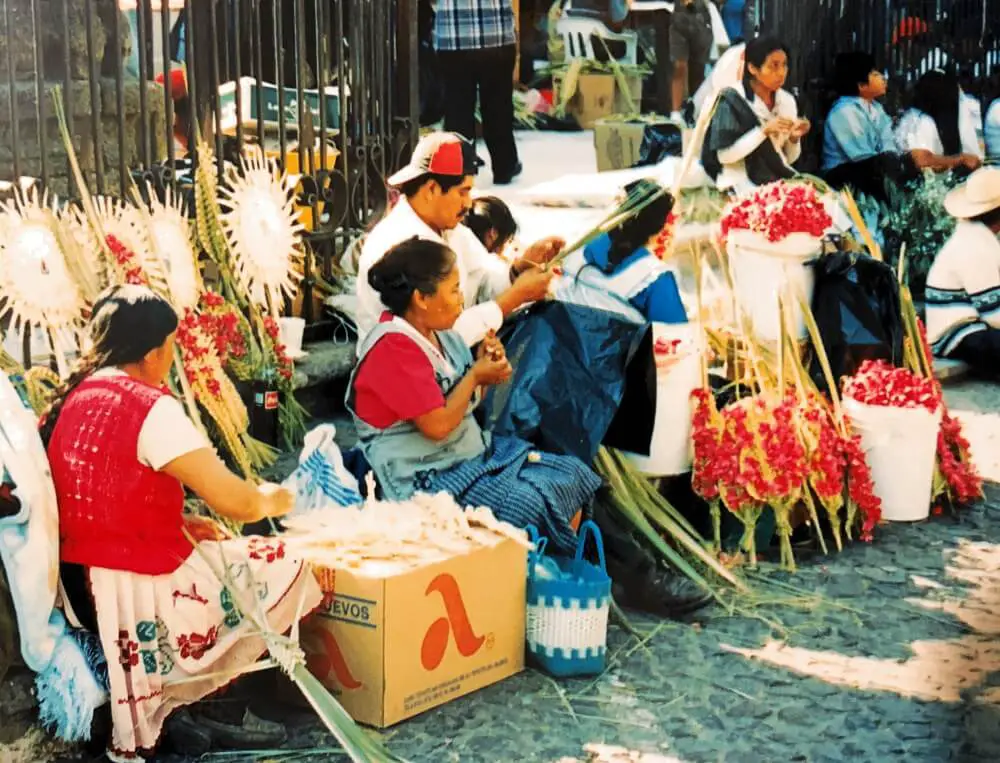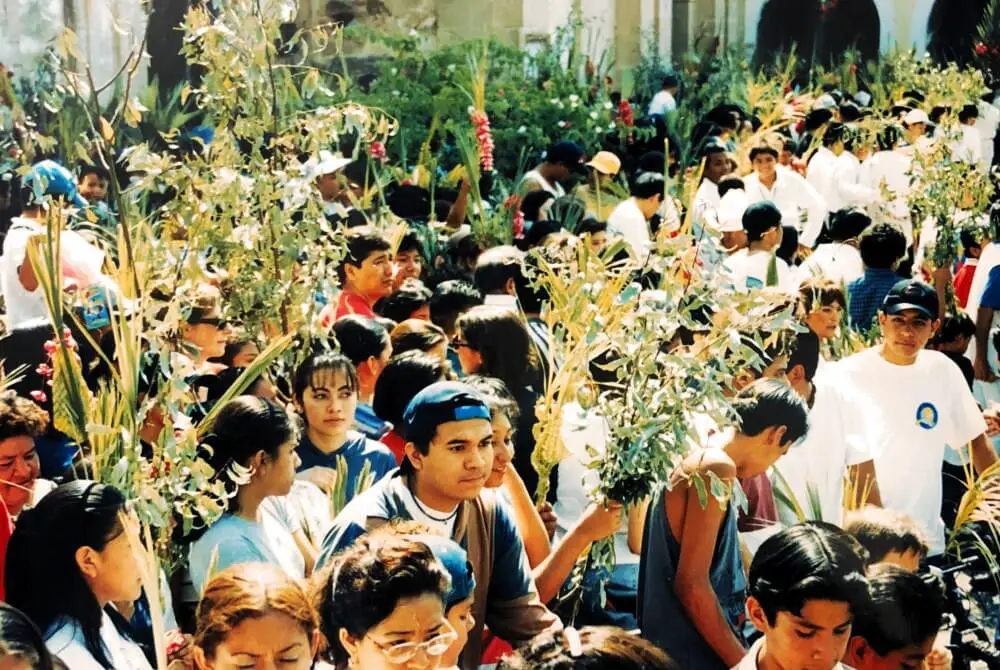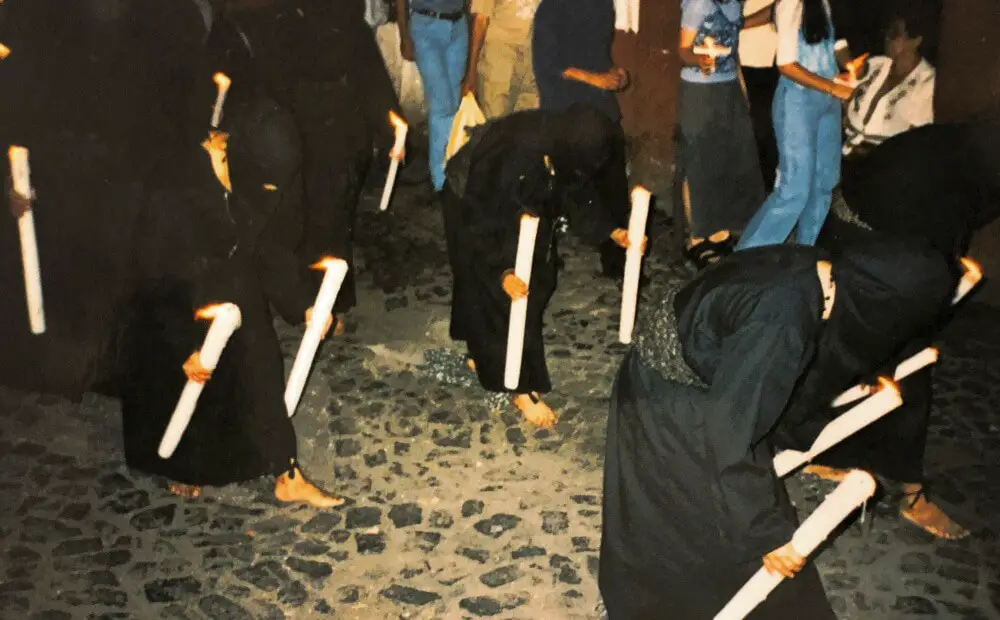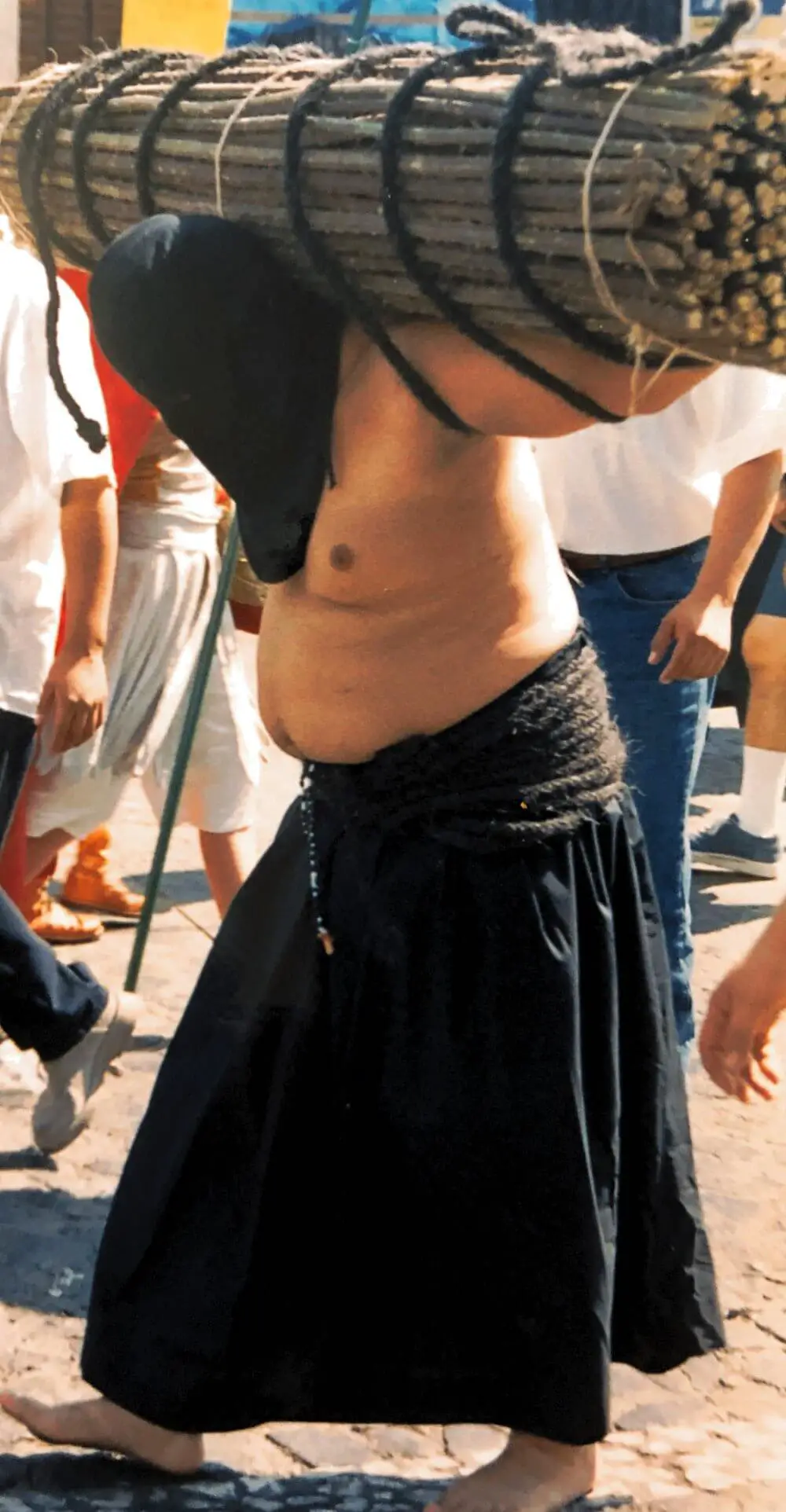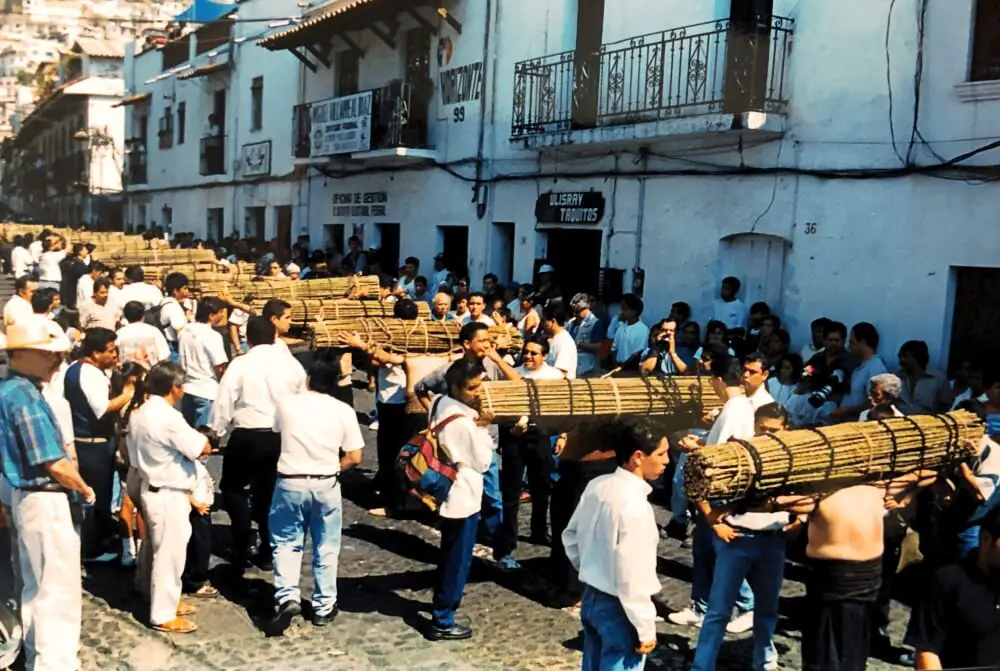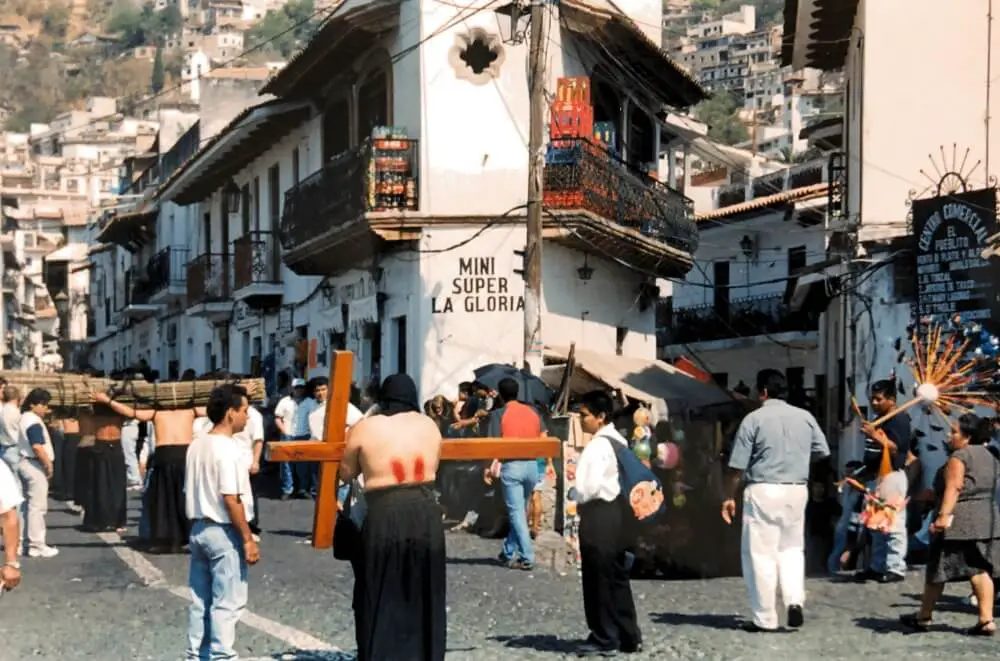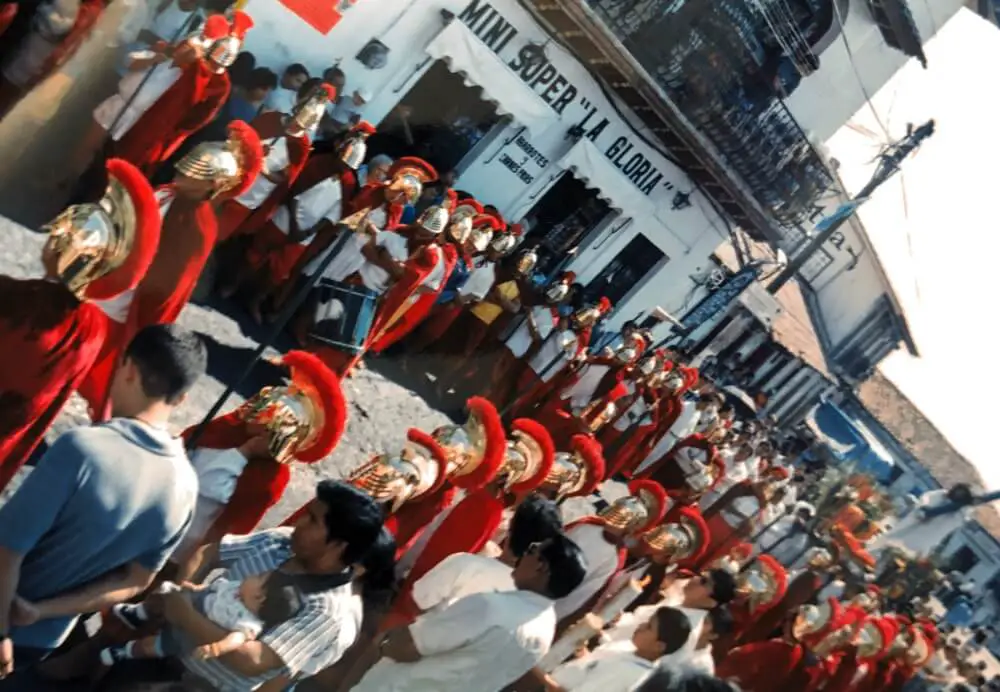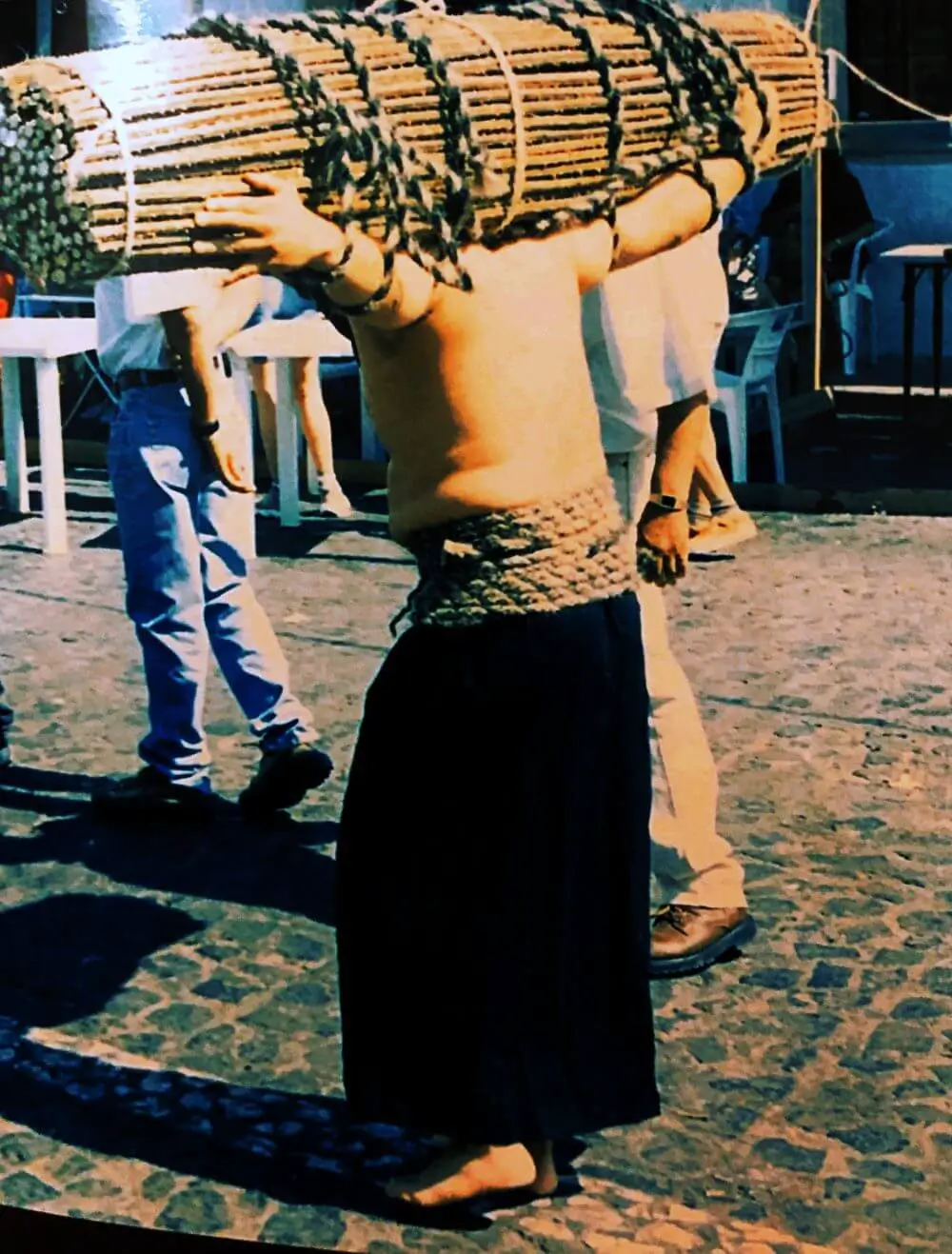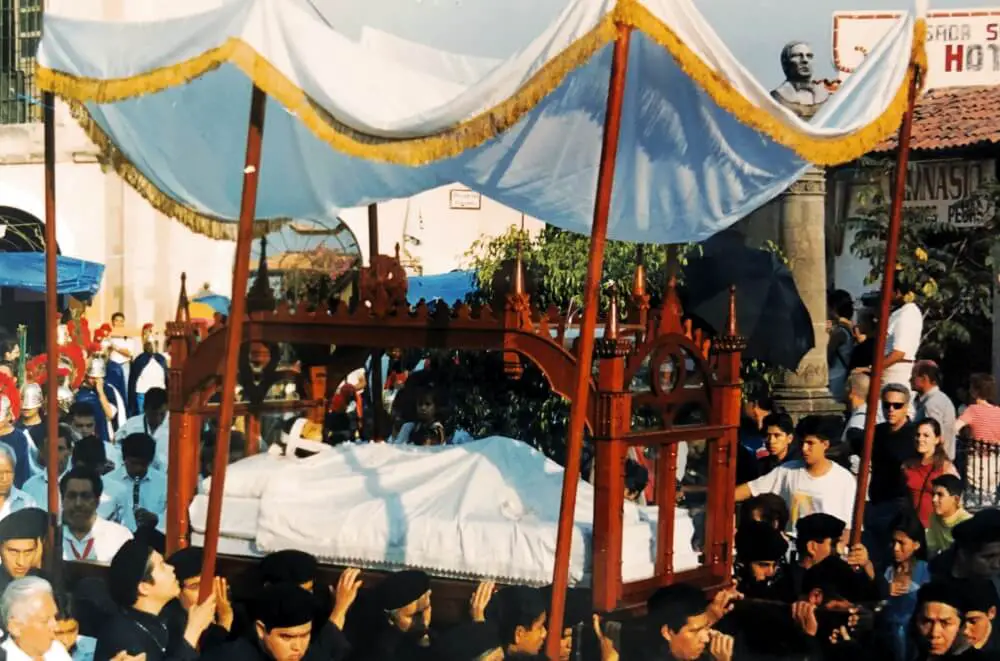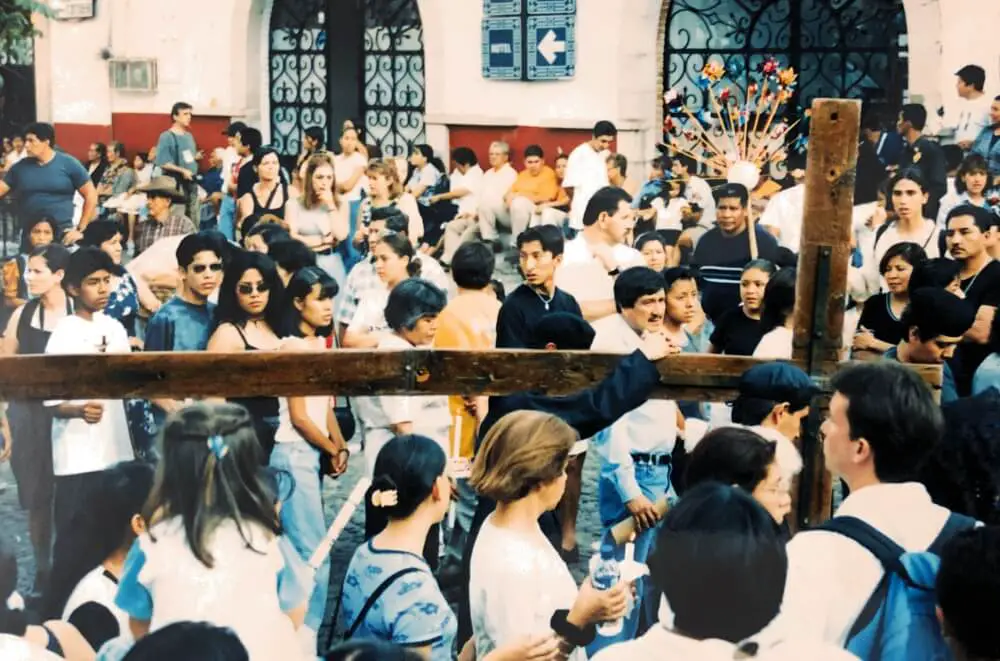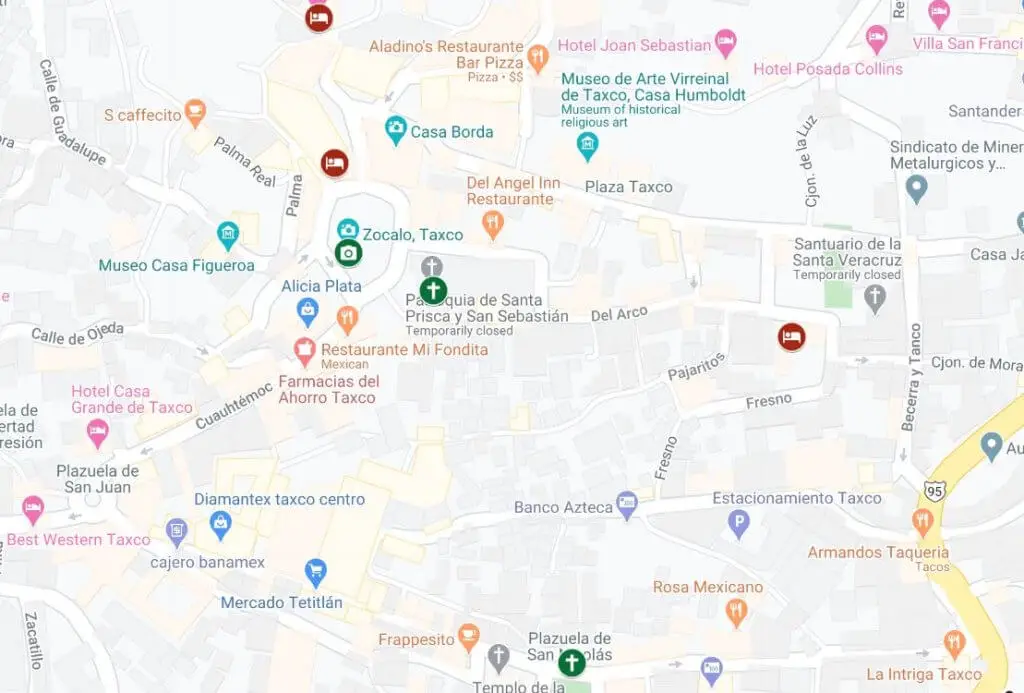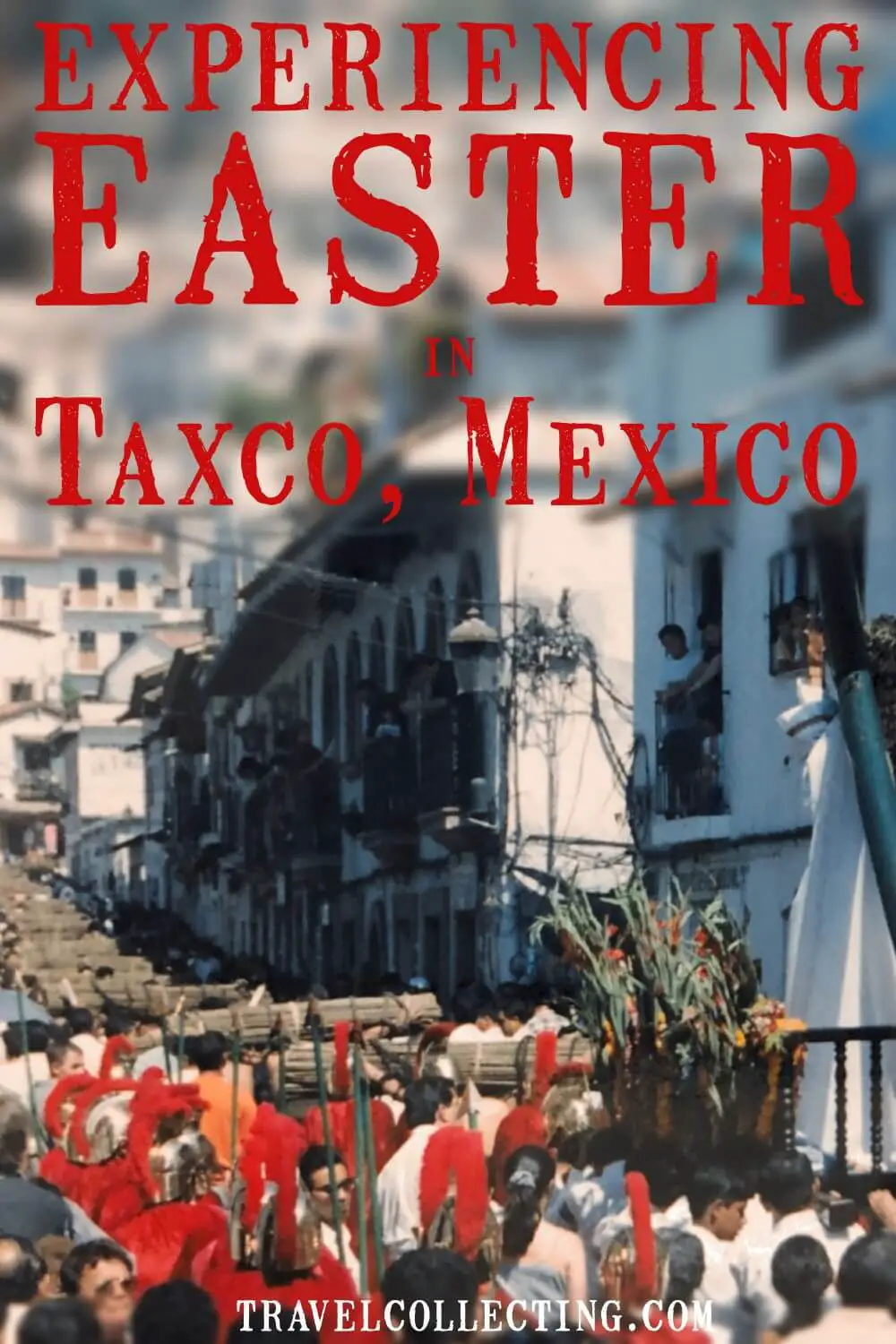Men, wearing black hoods and robes, bear heavy rolls of thorny sticks on their shoulders and outstretched arms. Rough rope rubs the skin around their waists raw.
More men, also hooded and dressed in simple back robes, bend over double as they drag heavy chains between their legs.
Others carrying two-meter-long thick wooden crosses on outstretched arms stop frequently to lash their backs with sharp thorns. This is not purgatory; nor is this medieval Spain.
This is Taxco, Mexico, and it is Easter.
No time to read about Semana Santa in Taxco right now? Pin it for later:
Please note this post may contain affiliate links, which means we may receive a commission, at zero cost to you, if you make a purchase through a link. Please see our full Disclosure for more information. If you have any questions, please let me know.
Experiencing a Week in Mexico at Easter
Taxco (full name Taxco de Alarcon) is a beautiful colonial town set dramatically on the side of a mountain with narrow, winding cobblestone streets. The buildings are typical Spanish colonial architecture, with white walls and orange, curved tiles and an abundance of colorful bougainvillea.
It is one of Mexico’s Pueblos Magicos (magical villages).
Subscribe to monthly updates with tips for planning, travel inspiration and trip ideas and get instant access to the free PDF of this
Guide to Semana Santa in Taxco, Mexico
The heart of the town is the main zócalo or town square, the Plaza Borda. The main church on Plaza Borda, the 18th Century Templo de Santa Prisca, is beautiful, with an ornate Baroque exterior and golden interior.
Taxco is most famous for its silver crafts, but one week a year, silver takes a distant second place to the Semana Santa traditions that dominate the town.
During Semana Santa, the center of Taxco and the Santa Prisca church are host to one of the most interesting Easter celebrations in Mexico, so on my trip to Mexico, I planned carefully to be in Taxco over Easter.
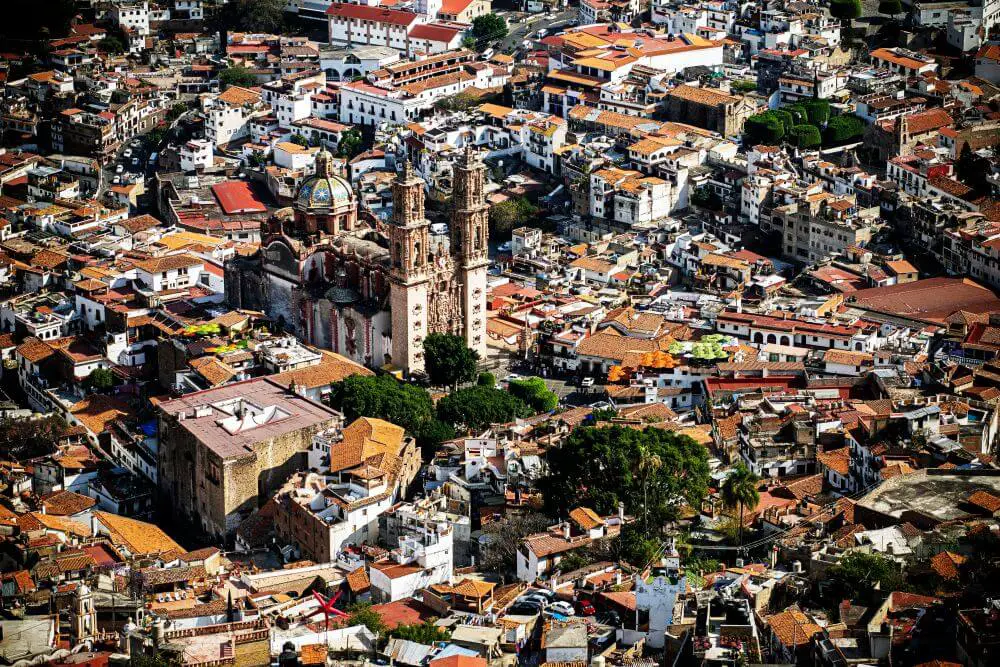
What is Semana Santa and how do they how do they celebrate Easter in Mexico?
Semana Santa is the holy week between Palm Sunday and Easter Sunday, and it is probably the most important of all Mexican celebrations.
Holy week in Mexico is, simply put, a big deal. So, how is Semana Santa celebrated? It varies from town to town, but it usually involves some kind of reenactment of Christ’s experiences in the week leading up to Easter Sunday.
Now, almost 500 years ago, the Spanish introduced the idea of showing penitence and proving your faith by self-inflicted pain, and the Mexicans, already used to blood rituals from the Aztecs, adopted this easily.
However, over time, this has gone out of fashion, and Mexican Easter traditions have become less gruesome, except in Taxco.
The people of Taxco celebrate holy week in Mexico by fully embracing the traditions of penitence and pain in a series of somewhat gruesome Semana Santa processions. One of things that I love doing when I travel is celebrating festivals around the world, including the Tapati Festival in Easter Island and Christmas in NYC.
The Holy Week processions in Taxco are the most interesting way to experience Easter in Mexico.
When does holy week start? The Semana Santa festival starts on Palm Sunday, the Sunday before Easter Sunday. The exact dates vary each year, but in 2021, Palm Sunday is March 28 and Easter Sunday is April 4.
So, let’s take a look at what to expect at Semana Santa in Taxco.
The Saturday before Palm Sunday
The zócalo is bustling with people selling handicrafts, pottery, balloons, juice and snacks. Most important though, are the ornaments being woven from palm fronds on the church steps by women from a small nearby village, Tlamacazapa.
Many of the palm ornaments are in the shape of Jesus on the cross, and many are decorated with flowers such as bougainvillea or garlands of frangipani.
Palm Sunday
A wooden carving of Christ on a donkey leaves at dawn from Tehuilotepec, a tiny village about 4 miles/ 6.5 km away. In Taxco, the Palm Sunday Easter procession starts at 10:00am and finishes at the zocalo.
Two lines of bicycles ridden by children and decorated with palm ornaments, accompanied by loud drums, mark the beginning.
Many of the cars in town are also decorated with palm ornaments in their bonnets/ hoods.
The procession is led by two priests waving smoke, holding staffs and splashing holy water on people. Then, preceded and followed by people dressed as the twelve apostles and a huge arch of palm fronds, the carving of Jesus on a donkey is carried on a platform decorated with palms and flowers, representing Jesus’ entrance into Jerusalem. Behind is a dense crowd of people, all holding their palm weavings in the air.
The carving of Jesus is taken inside Santa Prisca. Outside, the plaza is a bustling hive of people wandering around carrying palm ornaments, women weaving more, food stalls, shave ice refreshments, ice creams, balloons, chips, baskets, hats, real and fake flowers, handicrafts, etc. In the evening, a small stage is set up for a folk dancing performance.
Monday: Procession of the Virgins
The procession starts at 9:30pm from the Plazuela de San Nicolas, a small plaza outside one of the many churches in town. Various groups started amassing about 9:10pm. Semana Santa parades in which the events from the Bible are reenacted are common throughout Easter week in Mexico, but most towns have people playing the parts.
In Taxco, wooden sculptures from the churches in Taxco and nearby villages that represent the holy figures are carried on wooden litters instead. Some of them are large, elaborate and very heavy.
The Procession of the Virgins is just that – a large procession of dozens of statues of the Virgin Mary, usually by young women. Each one is accompanied by a group of women wearing white (most common) or black, barefooted and with heads covered with lace veils, holding candles or swinging incense burners to purify the air.
A couple of young girls bear large plates for donations – often in return for what I thought was a candy wrapped in purple or white paper.
I make a small donation and discover that it is actually just a cotton ball wrapped to look like a candy. There are also a few kids dressed as angels with wings. I count 33 virgins, but there may have been more.
As they pass by each church, the Virgins are returned to the church they originally came from, so only a few reach the final destination.
Tuesday: Procession of the Souls of Purgatory
I head to the Plazuela de San Nicolas about 8:50pm to see the start of the procession. There are several buskers, including a group in traditional costumes playing Mexican folk songs. The mood is festive, but this soon changes.
Penitentes are those people who show their faith and penitence by inflicting pain on themselves. The people carrying the often heavy statues and the women in white carrying candles are all penitentes, but more extreme are those who belong to ‘sacred brotherhoods’. Members of these brotherhoods prepare for the Holy Week festival all year. There are three brotherhoods in Taxco:
- the animas (the Bent Ones)
- the encruzados (the Crucified Ones)
- the flagelantes (the Flagellating Ones)
The penitentes all wear long black robes tied at the waist with lots of rough rope and black hoods with eyeholes cut into them.
The procession starts with a statue of Jesus on the Cross, then a double line of animas, walking with heavy chains tied to their feet, bent over double carrying two large candles each.
Then four encruzados carrying huge bundles of long, thorny sticks on their shoulders and outstretched arms. Then, in a cross formation, about 20 people long and 3 wide, more encruzados tied by one ankle along a huge, heavy chain in this formation, carrying large crucifixes in their arms – again bent over double and shuffling slowly.
There are several different groups of animas and encruzados and it is easy to imagine doomed souls weighed down by a huge burden, dragging chains for eternity in purgatory. This feels like something from 500 hundred years ago.
I walk in the opposite direction to get to a good vantage point outside the Ex-convento de San Bernardino de Siena. There are juice stands, corn sellers, cotton candy sellers, etc. and a generally festive atmosphere, which again changes quickly as the procession passes through.
By the time the penitents pass this point, many are looking worse for wear and they stop frequently, with help from assistants to ease their loads while the processions pauses. It is somber, but moving.
Wednesday: Procession of the Santísima Trinidad (the Holy Trinity)
This is somewhat similar to the procession from the previous night – very solemn and heavy on suffering.
There are a few statues of Christ, but this time there are more than a dozen encruzados – hooded, bare-chested men carrying huge loads of thorny sticks on their back of their necks, shoulders and outstretched arms. The thorns stab into them and the rope tied around their waists rubs their skin red raw. A few carry candles in their hands as well.
There are also a few flagelantes for the first time. They carry 2-meter crosses on their outstretched arms. Whenever the procession stopped, which it does frequently, two assistants support the cross while the penitentes lash their backs with ropes. The last three inches of the rope is double headed and covered with long, sharp thorns. They all very quickly have open bleeding wounds, which they hit over and over again. The blood is real. I feel queasy and faint and have to go and sit down for a while.
The rest of the procession is a few more people stooped over carrying candles, dragging a heavy chain tied between their feet and some more statues of Jesus. I feel a little lightheaded and return to my hotel to lie down.
Thursday: Procession of Jesus Christ
This is the day before Good Friday, a mock Garden of Gethsemane is set up in the forecourt of the main church (Saint Prisca) with a shaded roof, leafy branches covering all of the walls, a Jesus statue at one end and bird cages filled with birds to sing to Jesus hanging from the leafy walls.
People bring flower arrangements and more birds to put in front of Jesus throughout the morning. Freshly cut thorny crosses and postcards are for sale from a table set up in front of Jesus.
At 5:00pm, there is a mass in the Santa Prisca church. Around 6:15pm, a troop of Roman soldiers march around the main square. The arrest of Jesus in the Garden of Gethsemane is at 9:00pm.
A sermon is broadcast over loudspeakers as an endless line of hooded, bare-chested, barefooted penitents carrying huge bundles of thorny sticks on their backs and outstretched arms march from the Santa Prisca church to St Nicholas church.
Then the Roman soldiers come and carry out the statue of Jesus that had been installed in the Garden all day. The statue is now blindfolded, with rope tied around its hands. It is carried, preceded and followed by the penitents, the short distance to the Church of Saint Nicholas where it is installed in “prison” for the night.
The Procession of Jesus Christ then begins. The streets are crowded and food and drink stalls line the route. This is a longer route and a much larger procession than the previous nights. Views are better nearer the end of the procession, where locals set up chairs away from the main tourist crowds. The procession passes me about 10:40pm.
There are dozens of images of Jesus (Christ of This, Christ of That), similar to the virgins on Monday, usually accompanied by girls in white with lace veils on their heads, and someone waving scented incense.
Children dressed in white, with wings and a head band with a big ostrich feather stuck up from their backs accompany the parade. Interspersed between the Jesuses are the penitents – all three brotherhoods well-represented.
Good Friday: Procession of Silence
The first of several processions is at 11:00am. There are plenty of penitents, many with scabs on their backs from the previous nights. Then the Jesus that was installed in ‘prison’ overnight, now bearing a large cross on its shoulders and a fresh crown of thorns on its head, is carried through the streets, accompanied by Roman soldiers.
The streets are very crowded – it’s wall to wall people in the zocalo. A sermon is given at each church along the way, telling the story of Jesus along the stations of the cross. Statues of Jesus, Mary Magdalene, etc., are tilted, lowered, and moved around to enact the various actions along his journey. This is repeated at each church encountered along the procession route.
The funeral procession starts at 5:00pm, with another endless line of penitents. Dozens and dozens of encruzados carrying thorny bundles, many bearing flagellation scabs; a few dozen animas, hooded and stooped as they drag chains or hold candles; and several dozen (more and more every day) flagelantes.
Under a white canopy with gold fringing, in a glass coffin, is the bandaged corpse of Jesus, followed by a statue of Mary, wearing black and carrying the thorny crown, and a group of women in black holding candles.
The evening procession, the last, is the Procession of Silence.
The verdict: Semana Santa in Taxco, Mexico
Experiencing Semana Santa in Taxco is a very authentic and unique experience. It can be a little off-putting – seeing open wounds and people suffering does come with some emotions attached. However, it is a step back in time, and an incredibly interesting cultural experience.
Most Mexicans are out to have a good time, and the town is festive and fun for most of the time. It is also crowded, especially closer to Good Friday and the Easter weekend. The town is not big and the streets are narrow, so the crowds can be a little overwhelming. Earlier in the week is better.
Subscribe to monthly updates with tips for planning, travel inspiration and trip ideas and get instant access to the free PDF of this
Guide to Semana Santa in Taxco, Mexico
PRACTICAL TIPS: Experiencing a Week in Mexico at Easter
The Experience: Experiencing Semana Santa in Taxco, Mexico
This experience is free – but be sure to book accommodation and transportation in advance, as this is the week in the year that Mexicans travel the most, and Taxco is a popular town during Semana Santa.
Where is Taxco and what is the currency?
Taxco is in Mexico, and the currency is the peso. Check the current exchange rate here.
Visa requirements for Mexico
Depending on what country you come from, you may need a visa to travel to Mexico. For visa requirements, check out your home country’s official government visa websites:
For citizens of other countries, use this helpful website (though it’s best to always check with the embassy as well).
What’s the weather at Easter in Taxco, Mexico?
The average temperatures in Taxco, Mexico around Easter are:
March: 40°F – 67°F / 4°C – 9°C
April: 44°F – 69°F / 7°C – 21°C
How to get to Taxco, Mexico
Taxco is a three-hour drive or bus ride southwest of Mexico City. The main international airport in Mexico is the Benito Juarez International Airport in Mexico City.
How to get from Mexico City to Taxco by bus
The easiest way to get from the airport to the center of Mexico City is to take a shuttle. Book a shuttle here. You can also take an authorized taxi. (I do not recommend taking the subway with luggage in Mexico City, as it may not be safe).
There are several bus stations in Mexico City. The buses from Mexico City to Taxco leave from the Terminal Central de Autobuses del Sur, which is at Avenida Taxqueña 1320. Buses in Mexico are comfortable, but the bus stations can have pickpockets, so be wary.
The bus company with buses to Taxco is Estrella de Oro. Buses leave about six times throughout the day between 6:45am and 7:05pm at the time of writing and the journey takes 2 hours and 40 minutes.
If you can read a little Spanish, you can buy tickets and see prices and times on their website here. Choose these options:

Getting from Mexico City to Taxco by car
You can rent a car at the airport and drive to Taxco. Rent a car here.
Getting around Taxco, Mexico
You can easily walk around Taxco – it’s small (but very hilly).
Map of Taxco, Mexico
Where to stay in Taxco, Mexico
Semana Santa (Holy Week), the week before Easter, is one of the main holidays in Mexico and it’s best to pre-book accommodation and transportation.
Where you stay can make a big difference to your vacation, so read my guide to choosing the best hotel for things to consider. I wouldn’t recommend where I stayed, but the following are three good options:
Hotel Santa Paula has the highest rating on Booking.com and is in the city center.
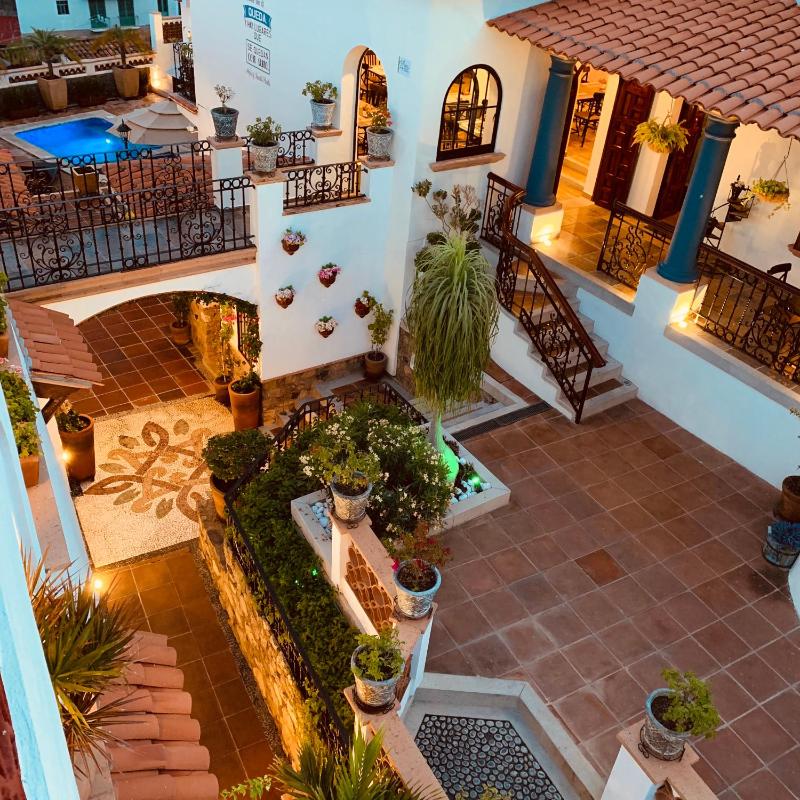
Hotel Agua Escondida has a high star ratings and is close the city center.

Book Hotel Agua Escondida here.
Hotel Mi Casita is also close to the city center and has good reviews.

Planning and packing for Taxco, Mexico
I use the Internet a lot to plan – and I hope this blog is useful resource for you – but I also always use a Lonely Planet to help with an extra perspective. Buy the Mexico Lonely Planet here. Also refer to my North America Travel Guide for essential information about Mexico.
Use my Trip Planner for a step-by-step guide to planning and preparing for your trip.
When you are ready for your trip, check out my Essential Packing List.
Safety in Mexico
Mexico is generally safe, but it is always a good idea to be careful. In small towns like Taxco, crime is not common; however with the large crowds at Semana Santa, be mindful of pickpockets in the crowds.
It helps to know common scams so you can recognize them when they start to happen – and get the hell out of there. Read about common travel scams and things not to do when travelling (learn from my mistakes!).
Additional consideration: Travel Insurance
In addition to accommodation, planning and flights, you should always have travel insurance, just in case. I always hope I never need to use it but I get it just in case I do!
A great insurance option is Travelex. It has coverage for all you’ll need. You can compare Travel Insurance plans here or get a quote right now:
Subscribe to monthly updates with tips for planning, travel inspiration and trip ideas and get instant access to the free PDF of this
Guide to Semana Santa in Taxco, Mexico
Enjoy the processions!
Do you have any stories of Mexico? I’d love to hear them. Comment below.
If you liked this post, please share the love and Pin it to your Mexico board for later!
Read about more Latin American experiences:
- Cycling down the Andes in Ecuador
- White water rafting in Peru
- Making chocolate workshop in Guatemala
- Taking a food tour in Santiago, Chile
- Tasting wine in the Maipo Valley, Chile
- Seeing glaciers in Argentina
About the author

James Ian has traveled to 83 countries and all 7 continents. He is passionate about experiential travel, i.e. meaningful travel that actively engages with the environment and culture. He helps people have similar experiences that involve active participation in activities and festivals; engaging with the local food and handicrafts through lessons and food tours; and interacting positively with environment by hiking, riding, rowing, diving and low/no impact animal encounters.
Travel Collecting is a participant in the Amazon.com Services LLC Associates Program, an affiliate advertising program designed to provide a means for sites to earn advertising fees by advertising and linking to amazon.com. Amazon and the Amazon logo are trademarks of Amazon.com, Inc. or its affiliates.


